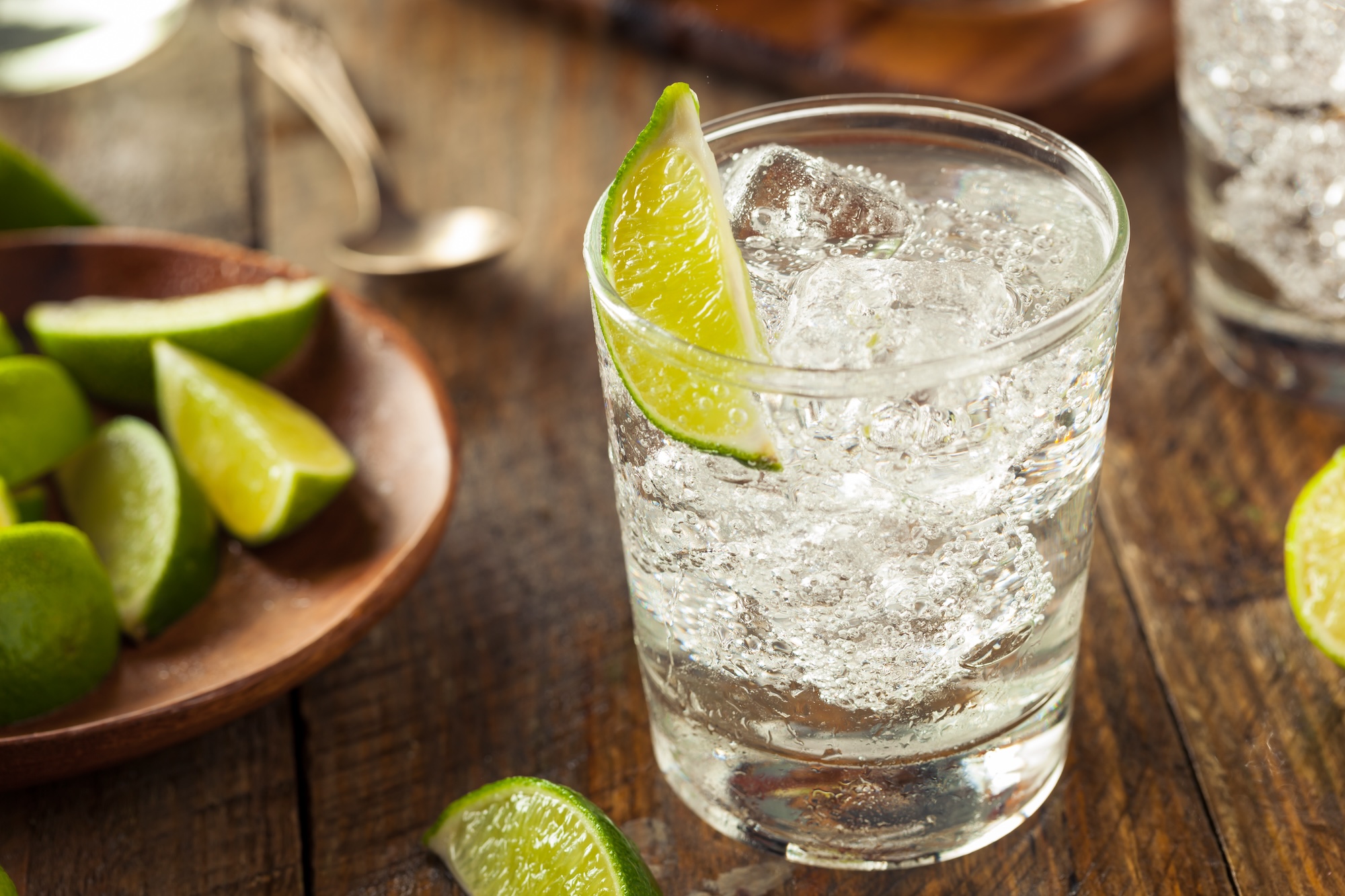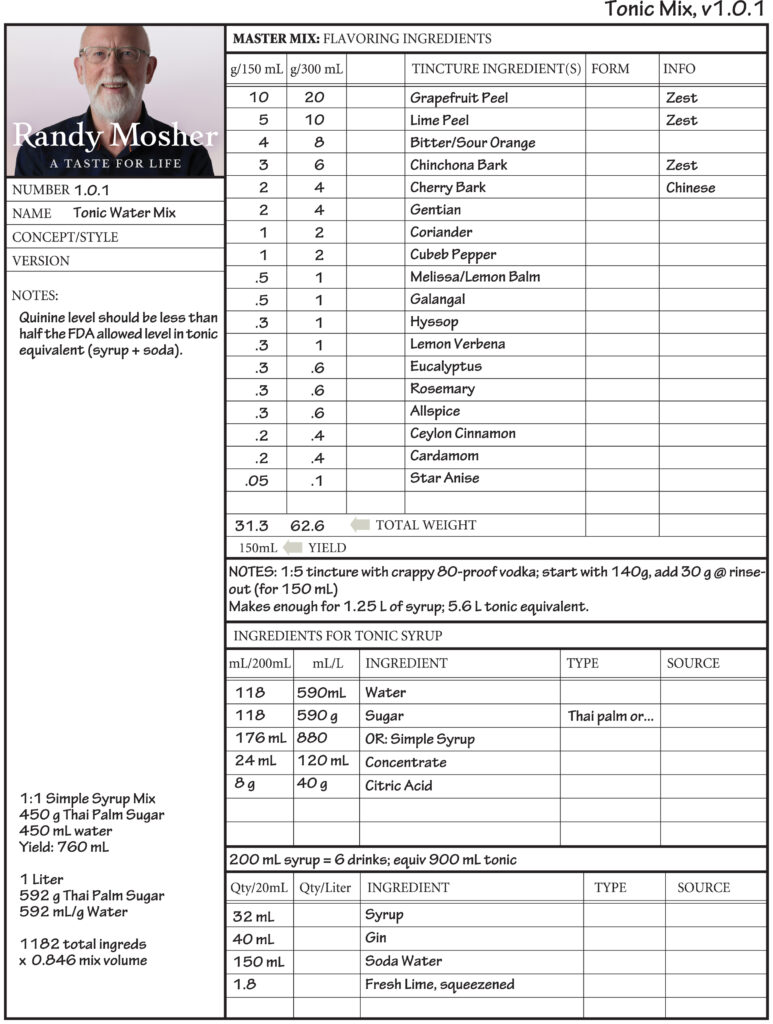© 2020, Randy Mosher
“Tonic” refers to quinine, which is used today as an effective anti-malarial treatment. It’s tightly raspy bitterness is at the heart of this medicine-turned-beverage, and is the reason it works so well to cut the sweetness as used in the famous cocktail. Grocery store brands are pretty one-dimensional, and the specialty brands seem expensive enough to at least investigate a DIY version.
In searching for background and inspiration, I could not locate any historical recipes, but besides the chinchona, the quinine-rich tree bark, most recipes have a mixed citrus component plus some spices for a little depth. The idea is to provide a rich, but bright backgrounds that supports the quinine, but doesn’t overwhelm the bitterness. Since I already have a trove of botanicals in my cupboard, this whole precess took maybe an hour of work, plus a few hours of soak time for the tincture. The final drink will have a slight yellowish color rather than the ice-white of packaged tonic. Lemon balm (melissa) and hyssop are classic Chartreuse ingredients, and have citrus/piney and fragrantly leafy qualities, respectively.
A note on chinchona and quinine:
Quinine is a phytotoxin, a chemical that contains some toxicity at high consumption rates, but may be inconsequential at lower doses. The FDA limits quinine content to 83 ppm for alcoholic beverages. Manufacturers generally use a pure quinine chemical, so they know precisely how much they’re putting into their products. Chinchona bark is somewhere in the neighborhood of 5% quinine, and we have to assume all of that will be extracted into the tincture, just to be safe. It’s a good idea to filter well; a French press is not a good filter for botanicals unless you’re just using it to make a coarse filtration that will be followed by a finer one through filter paper or a couple of layers of paper coffee filter. If you’re unsure, it’s generally safer to use chinchona chunks rather than powder, as they are less likely to remain in the finished mix. If your filtered tincture looks the least bit hazy, let it stand overnight to settle, then decant off any sediment.
With this recipe, made the way indicated below, the maximum quinine content is 45%, roughly half of the FDA limit.
If you want a tonic water without quinine, that is perfectly doable, as there are plenty of bitter and tannic botanicals that don’t have potentially toxic alkaloids in them. Gentian is bracingly bitter, but crisp, without the tannic bite of chinchona. Cherry bark is a bit bitter, but brings a lot of tannin. If you use 3 grams each for this tincture recipe, that should end up being pretty similar in taste to the chinchona. Quinine does have a unique ability to diminish sweetness, and this means that you may want to lower the amount of sugar in the syrup to compensate if you think the result is tasting too sweet.
This recipe is endlessly variable, as are the exact proportions of the final drink mix. If you like things sweeter, you could use double the amount of sugar in the pre-mix.
Step One: Tincture
I find this is the most controllable and practical way to make everything from bitters to amaro and other liqueurs. See recipe below.
You simply macerate ground herbs in cheap vodka for a few hours to a couple of days, then strain through a paper filter, like a couple layers of coffee filter. Then you have a concentrated flavoring liquid you can meter out into the final mix. Use a potato peeler to remove the citrus zest, chop into slivers.
Step two: Pre-mix Syrup Base
The idea is to make a flavored syrup that can be mixed with the gin, then topped off with soda water for the final drink. Most not-too-dark sugar will work; I used pale Thai palm sugar. Don’t use beet sugar, it’s a little lifeless because of sulfur compounds that can’t be refined out. If you’re using white sugar, make sure it says “Cane” somewhere on the bag.
Makes enough syrup for 5 Liters of tonic. Simply mix sugar, citric acid and water together, heat in microwave to speed dissolving. Sometimes the acid will precipitate some proteins or something from raw sugar, so filter if necessary. Allow to cool, then add tincture. Keep in fridge.
(makes 200 mL)
125 g Cane or palm sugar
118 mL Water
8 g Citric acid or wimaker’s acid blend
24 mL Tonic tincture
Step three: The drink
Mix the gin and syrup first, then add soda, stir, add ice, top with lime wedge:
1.5 oz/45 ml Gin
1 oz/28 ml Tonic syrup
6 oz/150 ml Soda water
Enjoy!
Click on recipe to download PDF


